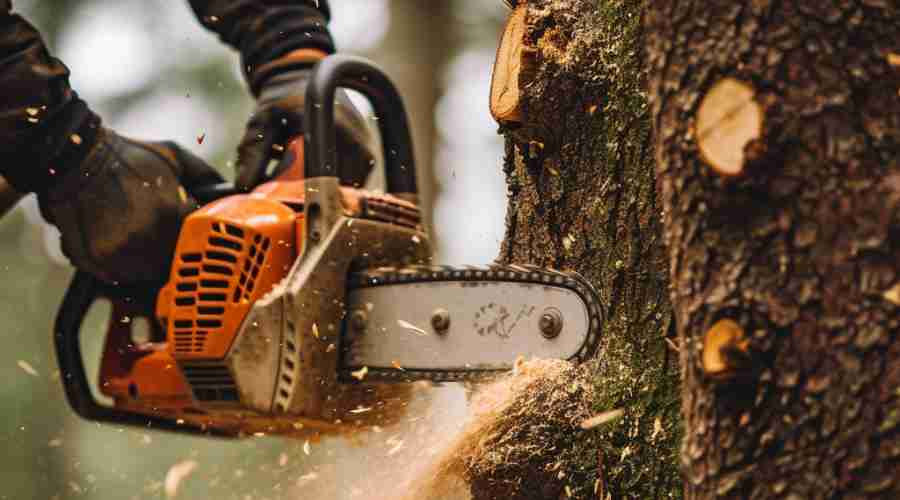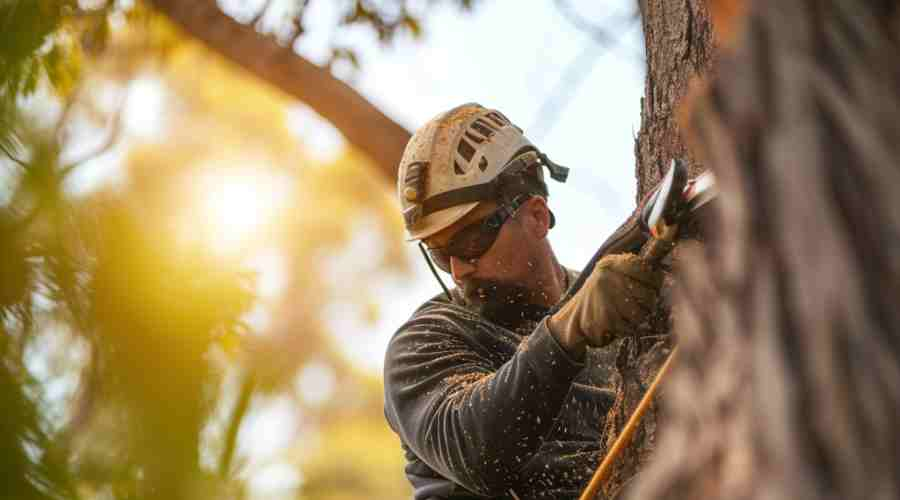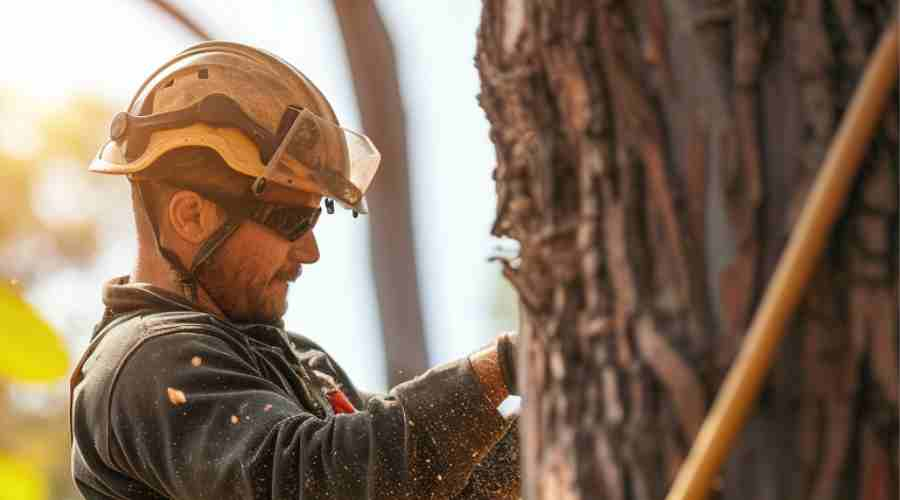DIY Tree Removal Tips
Safe Tree Trimming and Removal Tips for DIYers
Removing a tree yourself can save money compared to hiring a professional, but also comes with risks if not done properly. This guide covers tips for safe and effective DIY removal for smaller trees that do not present major fall or obstacle risks.
Why Consider DIY Tree Removal
For smaller, isolated trees under 30 feet tall and not near buildings or powerlines, DIY removal may be an option if you have the right protective equipment and skills. Reasons to do it yourself include:
- Save on professional removal costs
- Feel satisfied tackling a hands-on home project
- Have flexibility on when the project gets done
- Remove trees yourself carefully instead of just cutting them down
However, safety precautions should be the number one priority. Know your limits and when to call a pro.
Safety First – Know Your Limits
- No tree removal is completely without risk. Using a chainsaw and felling trees are among the most dangerous DIY projects
- Only attempt removal if branches can be dropped straight to the ground and the main trunk can be aimed/felled safely away from all structures, fences, power cable, roads, vehicles, etc.
- If anything around or on the tree poses a risk, stop and call a professional
- Never cut near power lines – contact your utility company to see if they can safely disconnect/reroute lines before removal
- Use extreme caution on ladders or for climbing – leave climbing to the professionals whenever possible
- Always wear safety gear: helmet, visor, hearing shield, gloves, steel-toed boots, long pants/sleeves
- Take it slow and don’t overexert yourself – tree removal is physically demanding work
Equipment Needed
To safely tackle DIY removal, you need at a minimum:
- Chainsaw: essential for cutting dead branches and felling trunks. Chainsaw training is highly recommended
- Loppers: for smaller branches that don’t require a chainsaw
- Pruning saw: helps precisely remove small branches in tight spaces
- Shovel: for digging around base of stump after felling to prevent regrowth
- Axe: useful for starting notch cuts to guide felling direction
- Gloves & safety goggles: chainsaws and flying wood chips pose risks to hands/eyes
- Helmet: protects your head from falling debris and potential overhead hazards
- Ear Protection: chainsaws and wood-chopping are loud enough to damage hearing
- Boots: steel/composite toe boots reduce foot injury risk from sharp tools and heavy logs/debris
Rope, wedges, and a chainsaw winch setup may also assist with directional felling for larger tree trunks. Consider hiring or buying only what you need.
Plan and Inspect
Before starting any cutting:
- Walk around the tree and inspect for hazards like power lines and buildings within striking distance of potential falling trunk
- Check ground slope and obstacles that could affect felling direction
- Plan which branches to cut in what order, identifying any weak crotches or spots with decay and instability. Aim to take off heavier branches on the sides first, then lighter branches, leaving main trunk for last
- Look for any signs of wildlife living in the tree and avoid times when animals may be nesting/denning
Safety Tips To DIY Tree Removal
With the right prep and protective gear, here are the basic steps or processes:
- Size up the tree, clearance space, and direction you want it to fall based on least obstacles and safety hazards
- Clear any brush, vines, or small trees around its base that could interfere with cutting
- Make a notch cut about 1/3 of the way into tree on the felling side
- Make a felling cut from the opposite side, 2 inches above notch, until it begins falling
- As tree falls, maintain awareness, retreat path, and distance – be ready to move!
- Once on ground, limb branches from trunk with loppers/chainsaw swiping away from your body
- Debark and section trunk, starting from base; move pieces to clear work area
- Finish by digging out tree stump and tree roots with shovel, mattock, or using a rented stump grinder
- Refill hole with soil; use remaining wood or give it away for firewood
Take breaks often when tired. Hydrate frequently. Ask someone to assist as a spotter if possible.
Having someone assist you can improve security. They can help watch for hazards while cutting and lend a hand moving pieces. An extra set of hands also lightens the workload.
Avoiding Common Mistakes
When tackling DIY tree removal, some frequent errors can lead to issues or property damage if precautions aren’t taken:
- Not having an escape route – Make sure you have ample room to move away quickly as the tree begins falling in case it doesn’t go exactly as planned. Avoid getting cornered between the trunk and obstacles like fences or other trees.
- Forgetting to sharpen your chainsaw regularly – Using a dull chainsaw requires more force while cutting and could get stuck or kickback. Frequent sharpening is key for smooth cuts and well being.
- Leaving partially cut trunks/branches overnight – Partially cut limbs or trunks can drop unexpectedly. Only start cutting what you can fully remove in one session.
- Not paying attention to which way the branch will fall – As you cut branches, be aware of the tension and how they will pivot. Don’t let them strike you or get pinned underneath.
- Improper felling notch/backcut – For directional felling, the notch and backcut angles and meeting point are vital. Research precise methods so the tree falls safely as intended.
- Assuming the trunk won’t bounce after hitting the ground – Trunks can pivot or roll downhill once on the ground if uneven or slanted terrain. Maintain a safe distance as it falls.
- Staying focused, alert, and using proper technique goes a long way toward avoiding mishaps. Take breaks when fatigue sets in and don’t rush the work – carefully executed cuts are essential.
Hiring a Pro Instead: DIY vs Professional Tree Removal Service
While DIY removal is feasible for some small-to-medium, low-risk trees, professional arborists bring knowledge and safety equipment the average homeowner lacks:
- Professional tree climbing gear and rigging skills for safe takedowns
- Larger trucks and cranes to lower large sections precisely
- Powerful commercial wood chippers instead of manual disposal
- Stump grinding proper tools that make quick work of digout
- Certifications related to safe electric line pruning
- Liability insurance and workers comp for employee injuries
- Emergency response plans for stuck/damaged entire trees
This allows pros to tackle taller, precarious leaners and removals near buildings most homeowners could not do safely. They also perform tidy grounds cleanup.
So while basic DIY tree cutting can save money, risk factors or oversized jobs call for hiring a licensed/insured arborist or tree company instead. They have the total package of gear, skills and practices developed through professional training and experience.
Frequently Asked Questions
What size trees can I remove myself?
It depends on experience level, but a good general cutoff is around 30 feet tall if the tree has a straight, single trunk and clear area to drop. Otherwise call a professional.
Should I climb the tree to cut pieces?
Climbing is extremely dangerous without professional gear/training. Never climb a tree with a chainsaw. Focus on cutting pieces you can reach from the ground.
How close to my house is safe for DIY removal?
It depends on roof height and felling space, but is risky within 1.5x the tree height. Potential damage can be costly, so carefully assess if professional help is best.
Can I cut down a tree near power lines?
Never cut trees or branches within 10 feet of utility lines without confirming disconnection by your utility company first due to electrocution risk. Leave these removals to qualified pros.
In Conclusion
DIY tree removal can be rewarding yet requires planning, diligence and extreme care to perform safely. Follow these tips to tackle it successfully within reasonable size limits based on your skill level. For large, precarious leaners near power lines or over 30 feet tall, the smart choice is hiring professional tree services to mitigate risks or personal injury. Work within your abilities, never compromise welfare, and don’t be afraid to call experts when needed.
Pro Tip:
When removing a single tree, even a healthy tree at ground level, advance planning is key. Before starting to cut down the tallest branch of a dead tree, ensure you have a permit in advance if required by your local regulations. Also carefully assess which direction the tree leans and where you want it to fall to avoid unintentionally felling it the wrong direction onto neighboring buildings or powerlines where it could cause major damage. Taking the time to properly plan your cuts and fall path can make all the difference in a safe DIY removal.



